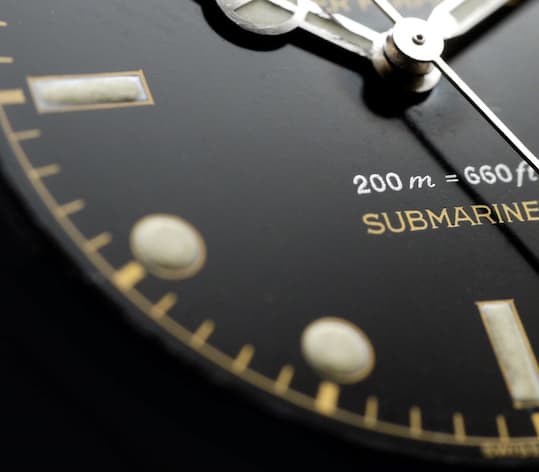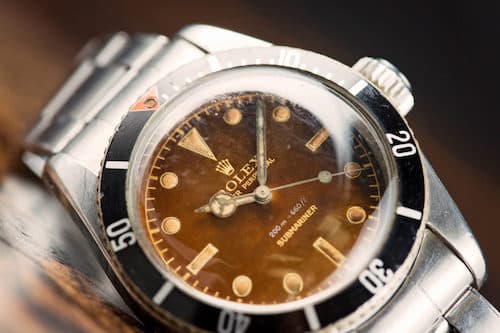
-----
Making black watch dials
April 15, 2021
Q. Hello
I am looking to replicate an old way of making a watch dial for my dad that was done back in the 50s. The process is this:
1) polish a brass disc
2) mask off the design on the brass dial
2) apply a 'galvanic'coating
3) remove mask
4) lacquer dial

What is my best option for a galvanic coating on brass? I am guessing it's plating it with zinc then applying a post plating conversion chemical to turn the zinc black or plate the brass in nickel then do a conversion on the nickel to turn it black but unsure of what would provide a quality result. I have tried brass blackening agents but not exactly getting the results I want.
Tommy Erwin- Houston Texas
A. Hi Tommy. I watched a number of youtube videos to try to get up to speed on the many ways to make watch dials. It appears that black paint is widely used, which would probably be the easiest, but if you want to do it by electroplating I think you should avoid zinc and start with nickel plating. After the nickel plating you still have a few choices: black rhodium [adv: black rhodium plating solution on eBay or Amazon [affil link] , ruthenium, and black nickel. In your particular case I'd avoid black chrome.
You can get black nickel plating solutions from hobby plating suppliers. The black rhodium or ruthenium plating solutions are available from jewelry industry suppliers, but read their instructions as some of the solutions may require a layer of gold or bright rhodium first. Best of luck.
Regards,

Ted Mooney, P.E. RET
Striving to live Aloha
finishing.com - Pine Beach, New Jersey
Ted is available for instant help
or longer-term assistance.
April 2021
Q. Would any of these options have the ability to change over time to a chocolate brown or light brown color? There is a term for dials that do this called 'tropical dials'. They faded due to UV light exposure over many many years.

Thanks!
Tommy erwin [returning]- Houston Texas
April 17, 2021
A. Hi. I read up a bit on those 'tropical dials'. Very interesting that when someone else makes a mistake the defective parts are less valuable, but that Rolex errors are so rare that they're worth more :-)

Luck & Regards,

Ted Mooney, P.E. RET
Striving to live Aloha
finishing.com - Pine Beach, New Jersey
Ted is available for instant help
or longer-term assistance.
April 2021
Q. So I have spent quite bit of time researching this. The black does appear to be black nickel. Talking to someone at the Nickel Institute, the tropicalization is due to oxidation of the black nickel most likely due to humidity from the breakdown of the lacquer over time. Is there a good recipe for black nickel plating solution that I could expose to high humidity prior to lacquering to mimic the browns/yellows of the old oxidized dials? Basically a "faulty" recipe that is guaranteed to oxidize when exposed?
Thomas Erwin [returning]- Houston Texas
March 1, 2022
A. Hi again. Humidity? I find it a bit hard to believe that the components inside Rolex [affil link] watch cases, including dials, are subject to the weather. Wouldn't you expect them to be hermetically sealed? Or maybe you're saying the moisture came from the lacquer?
You can buy a powerful ultraviolet light source cheaply as a fingernail lacquer curing station or maybe an old EPROM eraser ⇦ on eBay or Amazon [affil link] . Maybe see what a couple of days or weeks in such a UV-intensive environment does to a black nickel dial. Someone would have to have a lot more experience with black nickel that I have to figure out how to turn it brown :-)
Luck & Regards,

Ted Mooney, P.E. RET
Striving to live Aloha
finishing.com - Pine Beach, New Jersey
Ted is available for instant help
or longer-term assistance.
March 2022
![]() Humidity yep! The watches were often in a water environment. The gaskets that help make them water tight become brittle and fail overtime. If a little bit of moisture gets in and the lacquer no longer is protective you get the oxidation. Hopefully some black nickel experts chime in.
Humidity yep! The watches were often in a water environment. The gaskets that help make them water tight become brittle and fail overtime. If a little bit of moisture gets in and the lacquer no longer is protective you get the oxidation. Hopefully some black nickel experts chime in.
- Houston Texas
March 2, 2022
⇩ Related postings, oldest first ⇩
Q. Hi,
I'm building a watch to my own specs (for those interested: an ETA/Valjoux 7750 automatic chronograph). I would like to create a watch dial as dark as possible, giving the impression of inner space. Watch dials are aluminium or metal. I can put a silver or gold finish on it to start. Does anyone have a tip on how to proceed?
Best regards, F
watch design - Rotterdam, Holland, Netherlands
2004
A. Hi, Mr. Rincker. Aluminum dials can be anodized and dyed black, but for "metal" dials it will depend on what the metal is -- for example darkening processes for brass, steel, and stainless steel can be very different. I'm not fully clear on your "silver or gold finish on it to start", but maybe you're saying the numerals, etc. will be gold or silver and will be masked while you apply the topcoat? Topcoat choices might depend on what that underlying finish is though.
Paint, black nickel, black rhodium, or ruthenium sound like possibilities, but I have seen some black chrome that looked like lampblack used on the inside of tubing in microscope/telescope type optical applications.
If you're a watchmaker talking about making this design in volume, a PVD service would be well worth talking to, but they're very unlikely to fire up their multi-million dollar piece of equipment, and risk contaminating their high vacuum chamber for one or two dials for a consumer. We'll need more details please. Thanks!

Ted Mooney, P.E.
Striving to live Aloha
finishing.com - Pine Beach, New Jersey
Ted is available for instant help
or longer-term assistance.
2004
Q, A, or Comment on THIS thread -or- Start a NEW Thread